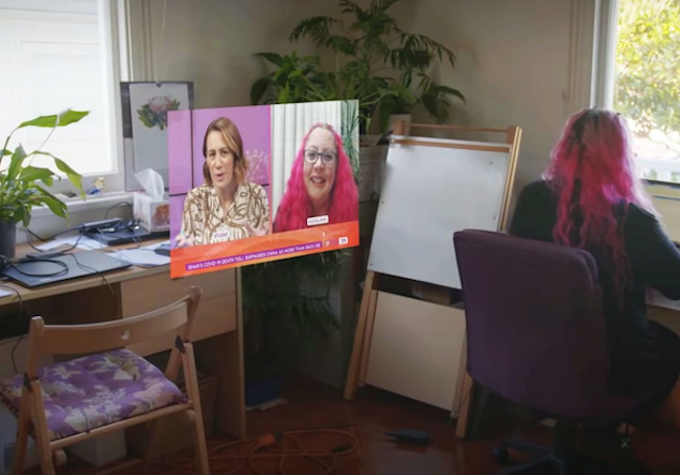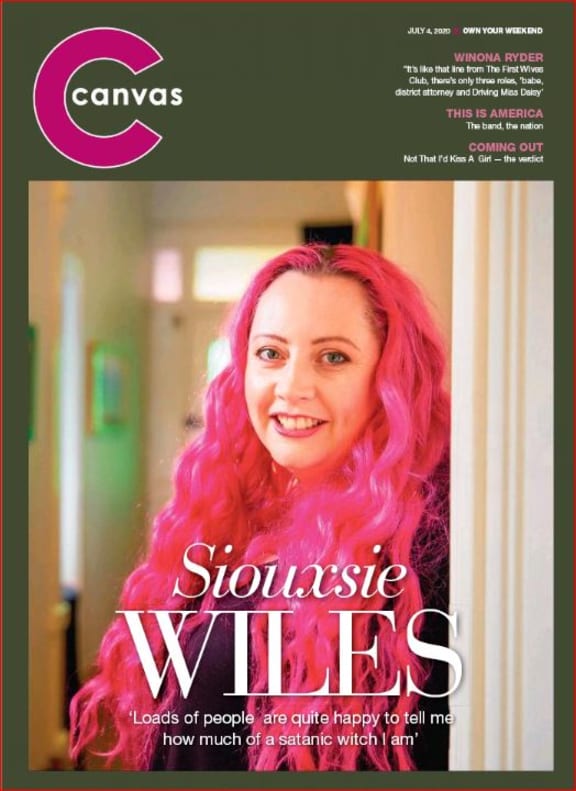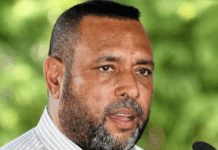
By Colin Peacock, RNZ Mediawatch presenter
Why did criticism of a modest sum spent on a single mini-documentary made two years ago suddenly spring up in the news in two national networks this week — and then disappear?
“I’m just so sick of everything getting taxpayer money for these projects. Why can’t people just pay out of their own pocket?” Newstalk ZB deputy political editor Jason Walls asked on air last Tuesday.
“I just keep seeing these things crop up time and time again, when we have hospitals overwhelmed. Twenty thousand dollars is not tons of money in the grand scheme of things, [but] that sort of stuff keeps adding up,” he added, noting Three’s latest Masterchef series aired and screened without draining the public purse.
More public money than ever is being spent on media content these days — and the spending does deserve scrutiny.
But the single project that triggered his concern this week was not a costly one — or especially newsworthy.
Siouxsie and the Virus is a short online video shot in March 2020 and it has been online for almost two years now, with its sources of public funding noted at the end. It snapshots Dr Siouxsie Wiles’ life in “fly-on-the wall”-style as New Zealand went into Level 4 lockdown.
It was made for the online platform Loading Docs which describes itself as “a launchpad for New Zealand documentary shorts.”
Enables short documentaries
It enables local makers to produce short documentaries which are then available to other media outlets. It is backed by the NZ Film Commission, the government broadcasting funding agency NZ On Air and Māori broadcasting funding agent Te Māngai Pāho.
Walls’ objections were rushed out as a news story online by Newstalk ZB and its sister paper The New Zealand Herald. The stories were shared on social media with the claim “the amount spent has left some gobsmacked.”
“Would you pay $20,000 for a documentary about ‘science superhero’ Dr Siouxsie Wiles? Because you already did,” the Herald’s story began.
On the air Walls had referred to $20,000 of Film Commission funding but said he wasn’t sure how Siouxsie and the Virus had been funded.
It turned out that sum relates to a different project yet to be made.
Loading Docs producer Julia Parnell told Mediawatch that Loading Docs provided $6000 in production finance and $2000 towards the post-production for Siouxsie and the Virus.
The funding model requires filmmakers to raise other funds themselves via crowdfunding.
Parnell told Mediawatch that Siouxsie and the Virus raised $7685 through the crowdfunding platform “Boosted”.
Boosted by The Herald
Ironically the mini-doco was also boosted by The New Zealand Herald back in 2020.

“It was launched in partnership with The New Zealand Herald on their platform, along with a high-profile story in [Weekend Herald supplement] Canvas. It then went on our platform, TVNZ On Demand, RNZ, PlayStuff and The Spinoff. It has had over 200,000 views and it has been so appreciated by audiences,” Parnell told Mediawatch.
Initially the director, Gwen Isaac, was funded to make a completely different film about a Kiwi MMA fighter in Japan.
“When the covid lockdown happened, we had to pivot and find something else. The director was able to get that access (to Dr Wiles) in that week prior to covid. It was a society-changing moment and we were able to capture it. I’m very proud of that,” Parnell told Mediawatch.
“Loading Docs has a platform-agnostic approach which means that more New Zealanders can connect with our work and the work of our documentary makers,” she said.
On social media, Dr Wiles pointed out on Thursday she made nothing from the mini-doco, and $20,000 would have cost each New Zealanders about half a cent.
She also pointed out NZME — the owner of Newstalk ZB and The Herald – received $9 million in covid wage subsidy in 2020 that would have taken $2.25 out of the pocket of every Kiwi.
LOL I just found out how much taxpayer money NZME who owns the NZ Herald and Newstalk ZB got in the first half of 2020. $8.6 MILLION! If you are a taxpayer, that’s $2.23 you paid. Oh, and their net PROFITS after tax rose by $1 million to $7.8 MILLION. https://t.co/pq6WhvnXyO pic.twitter.com/kOxQk0v5yM
— Dr Siouxsie Wiles (@SiouxsieW) July 21, 2022
Wage subsidies repaid
Some media companies — including Stuff and The Spinoff – repaid wages subsidies received in that year when business subsequently stabilised.
NZME has not, even after profits and revenue increased in 2021.
NZME CEO Michael Boggs told Mediawatch in April they used the wage subsidy for the intended purpose of retaining jobs and NZME declined the second tranche of wage subsidy when it was on offer.
Dr Wiles’ observations would have been relevant additions to The Herald and ZB online news stories highlighting the “gobsmacking” Film Commission funding decision, but by this time anyone who went looking for that would only find that those stories were not online anymore.
The Herald‘s link yields an error message that says, “Oops, looks like a dead end”.
The stories have been scrubbed from The Herald and ZB social media feeds without explanation.
Thanks @MediawatchNZ for looking into the dangerous hitjob Newstalk ZB and NZ Herald did on me last week. This was never about asking questions about the use of taxpayer funds. I honestly believe it was about stoking outrage, attacking the arts, & undermining & harming me. https://t.co/SdwWwF90z1
— Dr Siouxsie Wiles (@SiouxsieW) July 23, 2022
First funding questioning
Loading Docs’ Parnell said this was the first time the funding of any production had been questioned in the media.
But it’s not the first time ZB’s Walls has criticised public spending on media content.
Last year he labelled a range of arts projects bankrolled with covid recovery funds “a smorgasbord of abject waste” under the headline: Not a single cent more for podcasts, poetry and picture books in the name of ‘covid recovery.’ He wrote:
“It’s easy to take aim at the Creative NZ funding and to poke holes in what the government’s decided to fund through its $55m Public Interest Journalism Fund.”
Last year NZME secured up to $2995,702 from the PIJF to employ 15 reporters “to fill gaps in court reporting” in 11 of its publications — as well as two national reporting roles.
In 2020 — the year Siouxsie and the Virus was made — the PIJF allocated up to $200,280 to NZME for “a kaupapa editor and an audio innovation editor to improve access to news for blind and low vision New Zealanders.”
NZME also received up to $940,188 over two years “to retain reporting roles in its free community newspapers across Rotorua, Napier, Hastings, Whanganui, Manawatū, Taupō, Horowhenua, and Kapiti.”
More funding
An interactive NZME project exploring “how and when land became part of the Pākehā property system in Aotearoa New Zealand” got a further $80,500.
And just this month, the PIJF fund announced $255,000 of taxpayers money for a Herald series called Unraveling Anxiety.
This is based on a series of videos for The Herald’s website showing how people from different cultural backgrounds coped with anxiety disorders during covid-19 lockdowns and after.
It’s the kind of idea you might expect to find on a platform like Loading Docs, but so far The Herald and ZB have not aired any views on whether that is unjustifiably draining money from the public purse at a time of stress in our hospitals.
This article is republished under a community partnership agreement with RNZ.
Watch Siouxsie and the Virus on YouTube













































